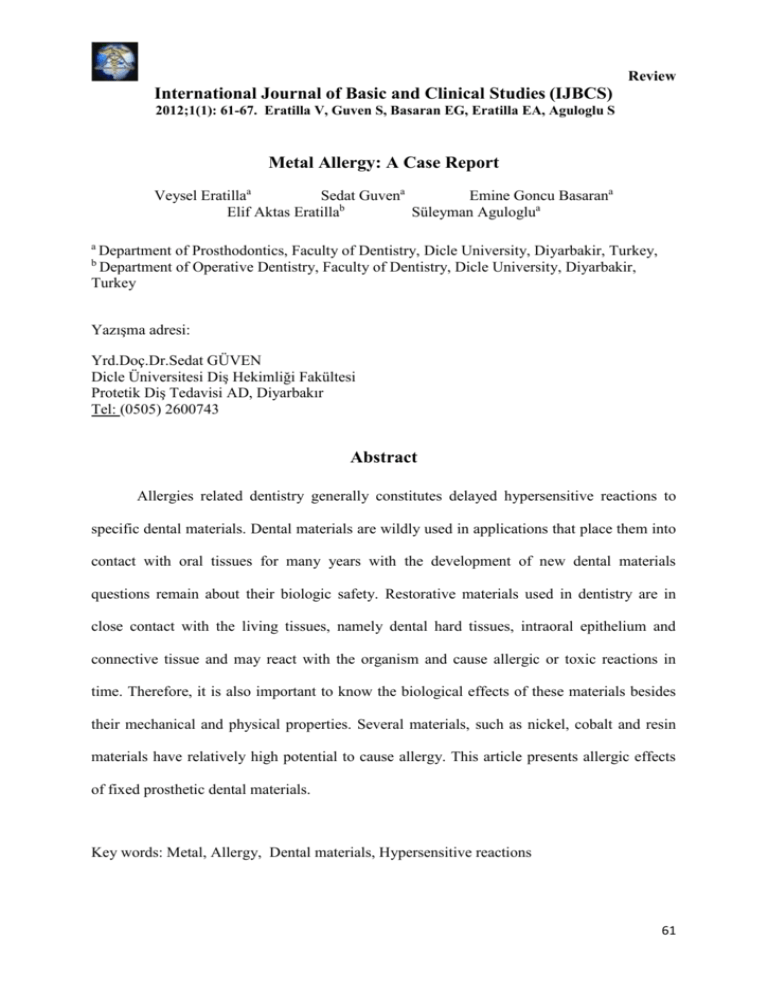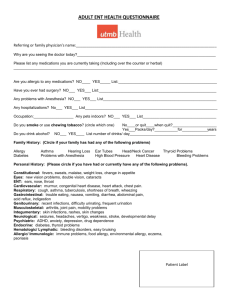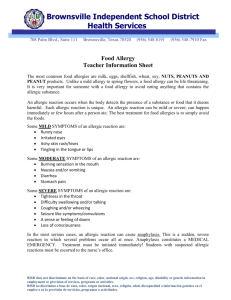6. Metal Allergy A Case Report Veysel Eratilla, Sedat Guven, Emine
advertisement

Review International Journal of Basic and Clinical Studies (IJBCS) 2012;1(1): 61-67. Eratilla V, Guven S, Basaran EG, Eratilla EA, Aguloglu S Metal Allergy: A Case Report Veysel Eratillaa Sedat Guvena Emine Goncu Basarana b Elif Aktas Eratilla Süleyman Aguloglua a Department of Prosthodontics, Faculty of Dentistry, Dicle University, Diyarbakir, Turkey, Department of Operative Dentistry, Faculty of Dentistry, Dicle University, Diyarbakir, Turkey b Yazışma adresi: Yrd.Doç.Dr.Sedat GÜVEN Dicle Üniversitesi Diş Hekimliği Fakültesi Protetik Diş Tedavisi AD, Diyarbakır Tel: (0505) 2600743 Abstract Allergies related dentistry generally constitutes delayed hypersensitive reactions to specific dental materials. Dental materials are wildly used in applications that place them into contact with oral tissues for many years with the development of new dental materials questions remain about their biologic safety. Restorative materials used in dentistry are in close contact with the living tissues, namely dental hard tissues, intraoral epithelium and connective tissue and may react with the organism and cause allergic or toxic reactions in time. Therefore, it is also important to know the biological effects of these materials besides their mechanical and physical properties. Several materials, such as nickel, cobalt and resin materials have relatively high potential to cause allergy. This article presents allergic effects of fixed prosthetic dental materials. Key words: Metal, Allergy, Dental materials, Hypersensitive reactions 61 Review International Journal of Basic and Clinical Studies (IJBCS) 2012;1(1): 61-67. Eratilla V, Guven S, Basaran EG, Eratilla EA, Aguloglu S Introduction Allergy is the respond to foreign substances or infectious organisms of the body. The term allergy is defined as the patherjik-hipererjik appearance of the diseases caused by antigen-antibody reactions. Allergic reactions should be evaluated in terms of time,type of reaction, physiological and histological findings(1-3). Allergy making substances can create four types of reaction by entering the body through the skin, eye and the nose. Type I.Atopic allergies. As soon as allergens enter the body immediately antigenantibody reaction starts. This type of allergy is genetically passed from parents to children. At these allergic types, asthma, angioedema, urticaria, rhinitis and conjunctivitis can be seen. At the most severe type, anaphylactic shock and death can be seen. Type II.Cytotoxic type occurs with the antibody against to the antigen. Autoimmune anemia, hemolytic anemia, and transfusion reactions are exemplified. Type III. Immune-complex type is inflammatory reactions starting with the binding of antibody and antigen. Type IV.Delayed type allergy reaction occurs due to some drugs, cosmetics and chemicals. This type of allergy reactions does not show any signs. Some symptoms may occur after 48 hours of exposure to the allergen. Vesicles on the skin beginning with erythema and burning and allergic contact dermatitis followed by thickening of the skin can be the examples of this type of allergy. Tissue will heal in a few weeks after the disappearance of the contact of the allergen (1,2,4). Type I and Type IV allergic reactions are common types of allergies to materials used in dentistry. On both the precious and non precious metal alloy groups there are alloys produced to be coated with the ceramic (5,6). To these alloys, adhesive oxide formers generating connection between metal and ceramic are added. Adhesive oxide formers are metals which can connect easily to oxygen. In general oxides are rich in number on the surface of metal and increase the durability of binding by interacting with coated ceramic (5). If oxides can not be moved away via saliva, they can break off from the surface and cause local damage. This situation mostly found in the gum pocket. A significant reduction in ion emission can be achieved with a well 62 Review International Journal of Basic and Clinical Studies (IJBCS) 2012;1(1): 61-67. Eratilla V, Guven S, Basaran EG, Eratilla EA, Aguloglu S polished surfaces and acidification . Although it may seem like minor threat, risk can be reduced with avoidance of the use of universal alloy (5,7,8). Metal restorations' defragmentation can be needed for reasons such as adaptation, extension or repairment of restorations. Using acrylic resins and soldering are proven methods for combining in dentistry. However, the corrosion caused by improper combinations of material leads to release of significant amounts of ions (5,9,10). If a patient has allergic basis intraoral symptoms and atopic diseases such as asthma, eczema, that patient should be treated with caution. A dentist should evaluate allergic reactions in the oral cavity well (1,4,11). Gingival changes that occur as a result of allergy are as follows: Erythema, edema, hyperplasia, vesicles and ulcers. Other sets of allergic reactions is an increase in the number of eosinophilic cells in the blood capillaries (1,11). To diagnose oral mucosa, many factors must be examined carefully by the physician. To be able to achieve a right diagnosis, a patient's medical history to age, sex, occupation, socio-economic status, lesion status, structure, uses drugs, foods, and factors such as systemic symptoms should be examined carefully by the physician. Dentist should learn about the patient's Idea about the cause of these lesions. Use of drugs, food, tobacco, alcohol habit may cause some of the lesions (1,12). The diagnosis of allergy in the mouth due to a metal depends on several criteria: 1. Contact with the patient's to the allergic material, 2. After removal of the material suspicious symptoms have turned, 3. Epicutaneous patch testing, 4. Metallographic analysis (1,13). In the clinical setting the first three criteria above can easily be understood if it is applied to allergic diagnosis of patients to the metal. CASE A 45-year-old female patient admitted to Dicle University Faculty of Dentistry Department of Prosthodontics with severe pain and swelling of gums. The patient has fixed prosthetic bridge restorations on the 13-17, 23-25-27, 34-35 - (36), 45-47 areas. The patient did not have any systemic problem. After learning the patient's pain began after placing restorations, the patient was referred to endodontics clinic for evaluation. The restorations 63 Review International Journal of Basic and Clinical Studies (IJBCS) 2012;1(1): 61-67. Eratilla V, Guven S, Basaran EG, Eratilla EA, Aguloglu S removed.(Picture 1) There were not any endodontic problems on the prepared teeth. According to the anamnesis, it has been understood that the patient could not use the necklace, ring or clock, even while eating she could use a wooden spoon instead of metal due to irritation of tissues. So, the epicutaneous patch test was decided to apply. 1-1 cm Cr-Co alloy was prepared in the laboratory and it was attached inside the patient's arm so hard by a bandage for a certain period of time. When she comes to our clinic next day, we have noticed a serious rash on where the metal is attached.(Picture 2) At the same time there was not any intraoral evidence and the pain complaint disappeared. The application of a new metal-supported fixed prosthetic restoration preventing the ion release to the patient's gingival pocket was decided to apply. The patient is allergic to all kinds of metal, so impression was taken with a special plastic spoon. Metal frameworks' edges facing gum were clipped 1mm away.(Picture 3) Thus, the contact of the gum and gingival pocket to the metal framework was prevented. Instead of the shortened metal extra porcelain was added, so porcelain was in contact with the gum.(Picture 4) The patient was recalled for 5-8 month intervals. There was no oral evidence and pain complaint.(Picture 5) Picture 1: after removal of allergen factor Picture 2: epicutaneous patch test 64 Review International Journal of Basic and Clinical Studies (IJBCS) 2012;1(1): 61-67. Eratilla V, Guven S, Basaran EG, Eratilla EA, Aguloglu S Picture 3: cripping edge of framework Picture 4: after inserting new restoration Picture 5: view of 8 month later Discussion Although dental restorative materials provide advantages, they have also some negative effects (14). The dentist should be careful about the material selection because some materials can be harmful for tissues. The use of dental restorative materials such as acrylic, resin and polymers has been very advantageous in dentistry. However, such materials can cause allergic reactions in some individuals (15). If patients had allergic symptoms and allergic reactions occurred during previous dental treatments it is best to comply with the following criteria: - If the patient has problems known as atopic diseases such as asthma, eczema, the dentist should be more careful to this group of patients than the nonallergic group ones. 65 Review International Journal of Basic and Clinical Studies (IJBCS) 2012;1(1): 61-67. Eratilla V, Guven S, Basaran EG, Eratilla EA, Aguloglu S - Intraoral lesions caused by allergic reactions should be carefully evaluated by a dentist. - Alloys of well known firms should be used, corrosion properties of alloys should be known well and precious alloys should be preferred in cases of unknowable corrosion properties. - If a patient is suspected of being allergic, his or her allergy tests (eg patch tests) should be ordered, and the results must recorded. - To avoid an early or a late developing allergic reactions, a first aid kit should be had present in clinic (16). Being aware of the potential allergens in dental restorative materials and knowledge of the contents may help protect both the patients, dentists and dental technicians' health (17). In addition, the determination of the possible harmful effects of these materials on human health is also important for the development of alternative sensitive materials (18). References 1) Baran İ., Nalçacı R. Dişhekimliğinde Kullanılan Materyaller Ve Alerjik Reaksiyonlar. Atatürk Üniv. Diş Hek. Fak. Derg. Suppl.:2, Yıl: 2007, Sayfa: 26-32. 2) Pretorius E. Basic principles of allergic reactions. South African Dental Journal 2002; 57: 332-34. 3) Nolte WA. Oral Microbiology. 3 ed. The CV Mosby Company, Saint Louis, 1980: 390- 512. 4) Mısırlıgil Z. Allerjik Hastalıklar. 2. baskı. Ankara Üniversitesi Tıp Fakültesi ANTIP AŞ Yayınları. Ankara, 2004: 52-64. 5) Çömlekoğlu M.E., Dündar M., Güngör M.A., Aladağ A., Artunç C. Dişhekimliğinde Alerji: Döküm Alaşımları, Polimerler Ve Seramikler. EÜ Dişhek Fak Derg 2008; 29:81-92. 6) Roberts HW, Berzins DW, Moore BK, Charlton DG. Metal-Ceramic Alloys in Dentistry: A Review. J Prosthodont 2008. 7) Joska L, Poddana M, Leitner J. Corrosion behavior of palladium-silver-copper alloys in model saliva. Dent Mater 2008; 24: 1009-16. 66 Review International Journal of Basic and Clinical Studies (IJBCS) 2012;1(1): 61-67. Eratilla V, Guven S, Basaran EG, Eratilla EA, Aguloglu S 8) St John KR. Biocompatibility of dental materials. Dent Clin North Am 2007; 51: 74760. 9) Nikellis I, Levi A, Zinelis S. Effect of soldering on the metal-ceramic bond strength of an Ni-Cr base alloy. J Prosthet Dent 2005; 94: 435-9. 10) Möller H. Dental gold alloys and contact allergy. Contact Dermatitis 2002; 47: 63–6. 11) Sandallı P. Periodontoloji. 1. baskı. Erler Matbaası. İstanbul, 1981: 81-93. 12) Şirin Ş, Özcan İ. Oral Diagnoz. İstanbul Üniversitesi Diş hekimliği Fakültesi Yayınları. İstanbul, 1997: 24-33. 13) Zaimoğlu A, Can G, Ersoy E, Aksu L. Diş hekimliğinde maddeler bilgisi. A.Ü Diş Hek Fak. Yayınları. 17. Ankara 1993: 393- 462. 14) Haberman AL, Pratt M, Storrs FJ. Contact dermatitis from beryllium in dental alloys. Contact Dermatitis 1993; 28: 157-62. 15) Kelly JR, Rose TC. Nonprecious alloys for use in fixed prosthodontics: a literature review. J Prosthet Dent 1983; 49: 363-70. 16) Puckett AD, Fitchie JG, Kirk PC, Gamblin J. Direct composite restorative materials. Dent Clin North Am 2007; 51: 659-75. 17) Goon ATJ, Isaksson M, Zimerson E, Goh CL, Bruze M. Contact allergy to (meth)acrylates in the dental series in southern Sweden: simultaneous positive patch test reaction patterns and possible screening allergens. Contact Dermatitis 2006; 55: 219–26. 18) Craig RG. Denture materials and acrylic base materials. Curr Opin Dent 1991 Apr; 1: 235-43. 67








